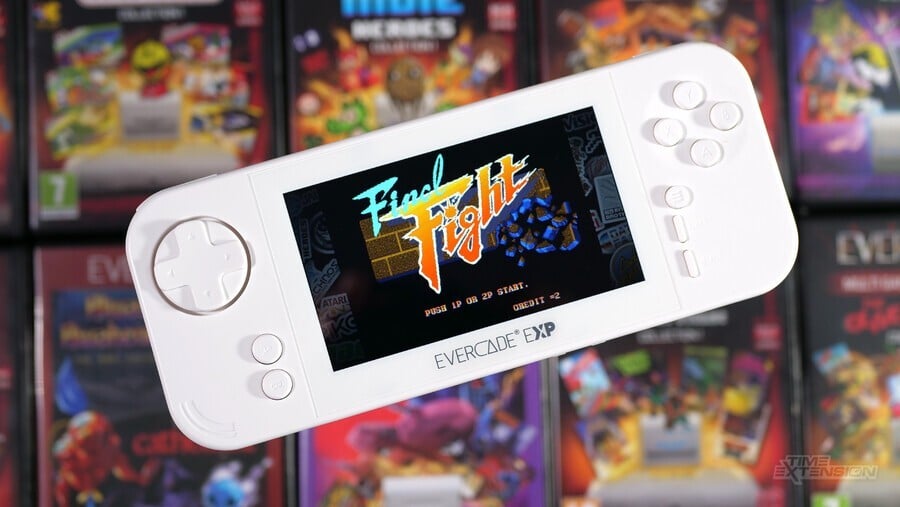When Blaze launched the original Evercade back in 2020, it felt like a pretty bold experiment.
The concept of a physical-only gaming portable which played retro games might not sound outlandish on paper, but the video game industry is moving closer towards a wholly-digital distribution model with each passing year, so there was a very real concern about whether or not people would actually buy a machine that relied solely on physical cartridges.
A few years on, it would appear that such pessimism was unfounded. While the Evercade clearly doesn't need to sell in Switch-style numbers to be considered a success, it has nonetheless performed admirably in commercial terms – so much so that we've seen a steady stream of cartridges since 2020 and even a home console variant in the form of the Evercade VS.
Now, more than two years after the launch of the Evercade line, we're getting a new handheld console, the EXP. Is it a solid evolution or a step backwards? Let's find out.

Evercade EXP Review - The Hardware
Compared to the original Evercade, the EXP is slightly wider and thinner, which makes it a little more comfortable to hold for prolonged periods. The rear of the device is made from textured plastic which provides enhanced grip, and, on the whole, the EXP's design feels like a proper evolution over its predecessor.
The unit feels solid and sturdy, with no movement in the casing when gripped tightly, and makes us think of the iconic Apple products of the 2000s, as well as the Nintendo DS Lite. The only real black mark against the EXP from a pure design perspective is the fact that, when played in complete darkness, you get some ugly light bleed on the bottom edge of the unit. During our initial hands-on with a pre-production unit back in October, we noted that it got quite hot after a few minutes – the final EXP model still gets warm, but it's nowhere near as extreme, even after a long period of use.
The rolling D-Pad and buttons are slightly spongey, but they're perfectly responsive. The shoulder triggers are much easier to use – and there are now L2 and R2 triggers with a nice curve on them, allowing them to sit underneath your fingers more easily during use. The additional buttons give the EXP parity with the controller that ships alongside the Evercade VS.
The 800x480 pixel 4.3-inch IPS screen is a massive improvement over the rather dismal one seen on the original Evercade; it's sharper and brighter and has rock-solid viewing angles – something the original machine didn't possess. It's also covered by a sheet of tempered glass rather than cheap, easily-scratched plastic – another big improvement.
The screen is definitely a step up, then, but's not totally perfect; the overall level of brightness is decent, but we'd argue it could perhaps have been a touch higher – although we'd imagine this would have had a detrimental impact on battery life. We have to admit, we've been spoilt by the screens on the Switch OLED and Analogue Pocket, both of which (it should be noted) cost significantly more than the Evercade EXP.

The real star of the show is the EXP's 'TATE' mode. A button on the bottom edge of the Evercade EXP rotates the screen so you can play arcade titles like Truxton and MERCS in the correct orientation. Two additional action buttons – located on the left-hand side of the screen – complete the control setup when played in this way.
It does take some getting used to playing in TATE mode, as the unit has been primarily designed with 'horizontal' play in mind; it sometimes feels like it's too top-heavy and is going to slip out of your hands. This is a minor complaint, however, when we're really pleased to see such a cool function included in a device like this – it certainly opens up the door for more authentic support for a wide range of arcade titles, including some of the best coin-op shmups.

Battery life is rated at between 4 and 5 hours per charge, according to Blaze, which is close to what we found during our review period; if you have the volume high and the screen brightness to max, you might find that the stamina falls short of that estimate. The unit uses a USB-C connector for charging, which is another improvement over the original, which used old-school Micro-USB. Wifi is included this time around but will only be used for firmware updates, according to Blaze – any dreams of a digital store packed with downloadable retro titles must sadly be put to rest for the time being.
Finally, there's 720P HDMI out via the mini-HDMI socket on the top of the unit, but you'll need to source your own cable.

Evercade EXP Review - The Software
Alongside the amazing TATE mode, the headline news regarding the EXP when it was first announced was the fact that it would ship with 18 Capcom titles pre-installed. This caused quite a bit of consternation among hardcore Evercade fans, as they felt this ran contrary to the platform's ethos of providing software on physical cartridges.
From what we can gather, it was Capcom that was the sticking point here rather than Blaze – and, given the quality of the included titles, we're sure most people would rather have them pre-installed instead of not at all. Sure, it's annoying that you can't take these games and play them on your Evercade VS, but it's certainly not the end of the world.





